Nijo Castle: Complete guide to Nijo Castle Kyoto 2024
Catalogue
- A Brief History of the Nijo Castle
- The Layout of the Nijo Castle
- The Ohiroma
- The Kuro-shoin
- The Shiro-shoin
- The Ninomaru Palace
- The Ninomaru Garden
- The Honmaru Palace
- Seiryū-en Garden
- Seasonal Blooms in the Nijo Castle
- Travel to Nijo Castle Kyoto
- The Nijo Castle Timings
- Admission Fee
- Facilities
- Special Openings
Show More
When you plan your next visit to the Land of The Rising Sun and Kyoto in specific, make sureyou have Nijo Castle in Kyoto in your list of must-see places. The castle lies in the heart of the city of Kyoto and has a very scenic charm owing to the old architecture as well as its many manicured garden that bloom during various periods of the year.
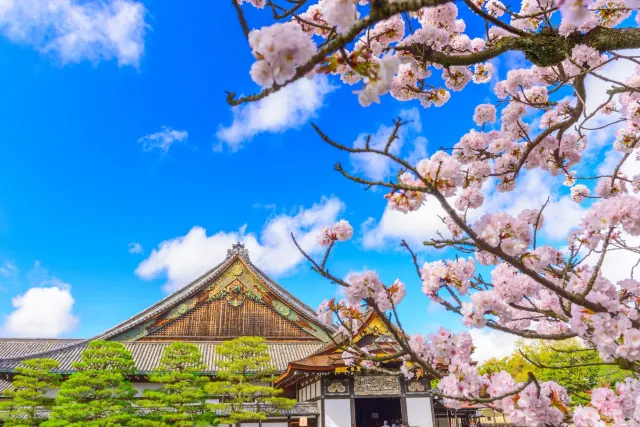
Nijō Castle has deep roots in Japanese history dating back to the 16th century. Although Japan has many other castles like Himeji and Hikone, Nijō Castle is one of the more complete examples of a traditional castle complex still remaining.
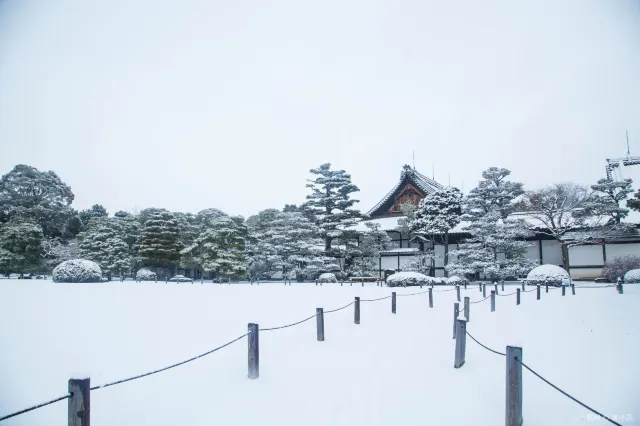
The history of the castle starts in 1601 when Tokugawa Ieyasu, the founder of the Tokugawa shogunate, demanded contributions from feudal lords of Western Japan and started the construction. Tokugawa Ieyasu was a prominent figure in the history of Japan as he was the first Shogun and also the founder of the Tokugawa shogunate that ruled the country for 2 centuries, from 1600 – 1868. It was not until 25 years later that his grandson Tokugawa Iemitsu completed the Nijō Castle.
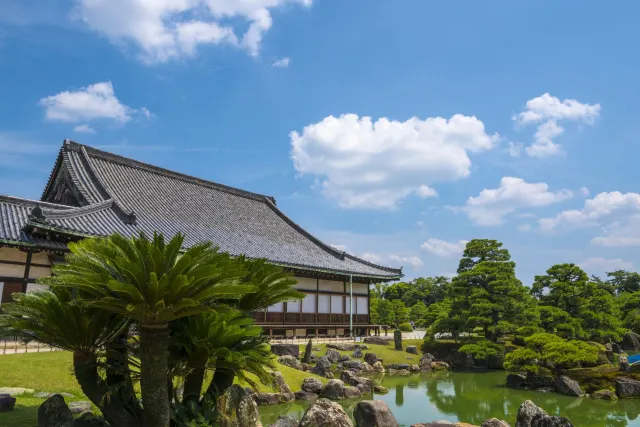
The main tower or the central keep of the Nijo castle was burned down in 1750 as it was struck by lightning. The only remains of the tower after the lightning is the stone foundation. Then again in the year 1788, there was another disaster. The great fire that swept Kyoto claimed the prestigious Honamru Palace.
In the year 1893, the Katsura Imperial family was relocated to the Nijo Palace from the KyotoGosho Palace that became the new Honmaru Palace. The beautiful Honmaru gardens surrounding the site were also created at this time. In the year 1939, the Imperial house donated the Nijo Castle to the city of Kyoto and in 1994 the Nijō castle gained recognition as UNESCO world heritage center.
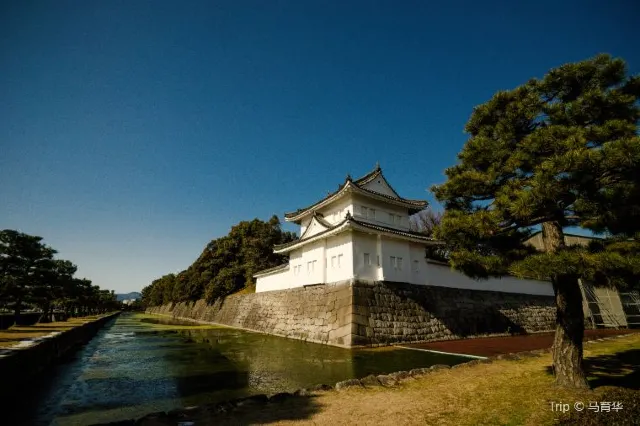
The castle layout can be summarised by two concentric rings of fortifications that include a wall and a wide moat. The outer wall of the castle has three gates where the inner wall has 2 entrances. The stone foundation of the 5 storeyed towers that was destroyed by lightning in 1750 lies in the southwest corner of the inner concentric ring. The inner wall surrounds the gardens, and the Honmaru (inner ward) Palace and the outer ward surrounds the Ninomaru Palace, kitchens, guardhouse, and several other gardens. The Main Entrance, The Great Eastern Gate (Higashi-Ōte-mon) lies on the eastern corner of the castle. There is another equally important entrance on the northern side, the Great Northern gate (Kita-Ōte-mon). The area inside the main entrance gate has 5 sections.
The Tozamurai
The guardhouse of the building, known as the Tozamurai is the largest building in the complex. The rooms in the guardhouse were occupied by the shoguns retainers. It even had the feudal lords and the visiting Imperial messengers occupying the room.
The Shikidai
This is the smallest building made up of only two rooms serving as the reception room for the castle. The highest raked councillors of the government were based here to welcomes visitors and to collect gifts from them.
The Ohiroma is the chamber where the Shoguns met the feudal lords. The hall had a tiled ceiling and heavily decorated wall panels. The raised floor of the Ichinoma chamber was the place where the shoguns sat, and the feudal lords who came to visit would sit below in obeisance in Ninoma.
This area was the shoguns personal inner audience chamber. This chamber also had a tiled roof as in Ohiroma. The other styling and the layout is also the same as the Ohiroma.
The Shiro-shoin served as the personal residence of the Shoguns. The residence had his sitting room and bedchamber. The rooms are beautifully decorated with ink sketches adding elegance to the rooms.
The vast Ninomaru Palace inside the gate consists of five buildings, 800 tatami mats, and 33 rooms. The primary material used for construction is the Hinoki cypress. The base of the palace is made with square masonry, and the rood was made using cypress bark. The palace was designed by the artists of the Kano school who displayed much attention to detail for the woodwork and painted screens. The rooms of the Ninomaru palace represented the political situation of the society at that time, and the seating arrangement was also made based on the hierarchy of political position.
At the entrance of the Ninomaru Palace, you are greeted by the sight of the Karamon, a traditional Chinese style gade that has a curved roof particular to Japanese architecture, called theKarahafu. Do start your photo op with this iconic and impressive entrance. The gate is covered with gorgeous wood carving and beautiful detailing to exhibit the craftsmanship of the artists who carved it.
The Nightingale floors of the area between the Ninomaru palace and Ohiroma need a specialmention. These unique wooden floors would squeak when they were walked by someone. The chirping sound created when someone walks over them is similar to the bush warbler bird song. The bush warbler bird is known at the Japanese Nightingale and based on its name, the floors are known as uguisubari (nightingale floors).
The Ninomaru palace is surrounded by a beautiful strolling pond garden known as the Ninomaru Garden. This beautiful piece of landscape is designed by the famous architect and tea master Kobori Enshu. The garden is developed around a large central pond and is accentuated with a variety of pebbles as well as stones of all shapes and sizes. The pond has 3 islands, Hōrai-jima - the Island of Eternal Happiness, Tsuru-jima - the Crane Island and the Kame-jima - the turtle Island. Make sure you take out some time to spend in this garden. The Ninomaru Garden was ranked 8th out of 731 gardens all over Japan by the American Magazine Journal of Japanese Gardening.
The Honmaru Palace of the Nijō Castle is a 20,000 square meter area which is surrounded by the inner moat, and wall featuring a garden and palace. The area boasted of beautiful rooms designed by the same Kano School and hence was similar in architecture to the Ninomaru Palace. In the year 1788, a wildfire consumed the Honmaru place. The existing building on the site was transferred from the Kyoto Imperial Palace in the year 1893, after the fall of the reign of the shogunate. The new Honmaru palace building is not open to the public on a regular basis, but there are exclusive viewings in the fall season when you get a chance to see the inside of the new Honmaru palace.
Among the new manicured gardens of Nijō Castle is the Seiryu-en Garden. This contemporary garden is manicured in half western and half Japanese style. The garden was built in the year 1965 and was named Seiryu-en by the then Kyoto's Mayor, Yoshizō Takayama. The garden is mainly used for cultural events like tea ceremonies and is also used as a reception facility for the official guests of the city. The 16,500 square meters complex consists of two tea houses, over a thousand stones, a beautiful pond and many more.
There are many species of the cherry trees that are planted around the castle grounds including 400 cherry trees of the late-blooming variety in a cherry blossom orchard. The flowering season of this cherry orchard starts from late March and feasts the eyes all through the end ofApril.
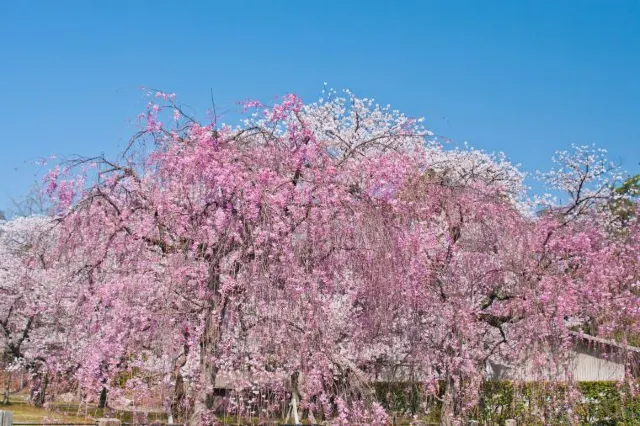
The Nijo Castle Kyoto also features a Plum orchard that comes to full bloom from late February to early March.
Another bloom that attracts many visitors is Tsubaki. 50 different varieties and 400 plants were planted at the Nijo Castle in the year 1953. The bloom starts in December and lasts upto mid-April. The flower holds cultural significance in Japan and is used in many rituals as well as beliefs.

You can reach the Nijo Castle by bus. The Raku 101 Bus is a perfectly viable option as it is a tourist bus and the announcements are also made in English. The bus covers the central west area, and you can also visit the Golden Pavilion, Ryoanji, Kitano Tenmangu shrine and also the Nishjin textile centre that comes in the route.
The subway is another very convenient option to reach Nijo Castle. The entrance of the Castle is just a short walk from Nijojo-mae Station that falls along the Tozai Subway Line. If you are coming from Kyoto Station, at first, take the Karasuma Subway Line to Karasuma-Oike and then transfer to the Tozai Line that takes you to Nijojo-mae Station. The whole travel takes about 15 minutes and costs about 260 yen.
8:45 am to 5:00 pm during the period of October to June;
8:00 am to 6:00 pm during July and August;
8:00 am to 6:00 pm during the month of September.
The Palace is closed from December 29-31 and the Ninomaru Palace is also closed on Tuesdays in January, July, August, and December.
The admission fee is 600 yen. You will have to pay an additional fee of 400 yen to enter the Ninomaru Palace.
If you are looking to hire a guide for better understanding of the palace and its history, goodEnglish audio guides of the castle are available for 500 yen here. You can also avail a 60-minute tour of the castle with commentary in English that is conducted twice a day for 1000 yen.
There are also restroom facilities and tea rooms for your convenience. The castle also has a souvenir shop so swing by and pick up a gift for your loved ones.
There are special openings during the spring and autumn as the cherry blossoms are in full bloom and great autumn colour are all around the grounds of the Ninomaru Palace as well as The Honmaru Palace. During the spring opening, the grounds are lit and open during the evenings too.

More about Kyoto:
Trending Travelogues
Popular Trip Moments
Popular Travel Types
Popular Attractions
Popular Ranked Lists
Popular Destinations
Recommended Attractions at Popular Destinations
About











Site Operator: Trip.com Travel Singapore Pte. Ltd.







